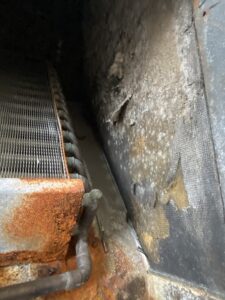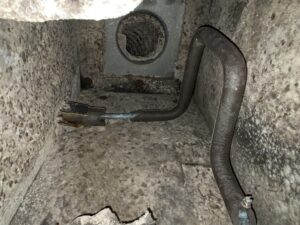There’s a reason the word “mould” can raise anxieties in condo property management. Gone unnoticed or left to grow, mould can become a significant health risk to occupants and lead to costly building repairs. This is why it pays to understand where mould can appear and how best to banish it from your building.
The origins and impacts of mould are well documented. And as a study by the University of Toronto’s Department of Physical and Environmental Sciences, Fan Coil Contamination of Growing Concern: The effects of mould growth within fan coil units in Canadian high-rise buildings, the risks of leaving it grow unabated within are clear, especially when it pertains to HVAC systems: “there are sensitive individuals for whom exposure is a serious issue, and concern for this subset of the population dictates that a solution is found in a timely manner.”
A microscopic threat
While fungi are critical members of healthy ecosystems, a public health risk exists where there is an overlap of receptors, hazard, and exposure. Mitigating mould requires an understanding of how and where it can take root. The ingredients for mould are quite simple; all it takes is a little moisture, air, and some food, the latter of which can be a broad range of organic materials such as wood, paper, dead skin cells, synthetic materials, and beyond. Mould doesn’t require much to start spreading, and once it does, it can begin showing itself within days.

One of the more desirable – but less noticeable – “hot spots” for mould is within fan coil units (FCUs). Relative humidity (RH) levels within these heating and cooling systems are between 75% and 97%, which is an ideal range for mould growth. Moreover, the materials around fan coil units (e.g., insulation) often hold moisture, providing the right foundation for mould spores to thrive. Put these elements together, along with a lack of maintenance, and it’s no surprise that mould is a common consideration for any fan coil unit.
As UofT’s study affirms: “FCUs are highly susceptible to becoming contaminated with mould and distributing spores throughout the living areas. Since these units are out of sight, they are often out of mind, a situation that poses potentially serious health and legal risks.”
A breath of (un)fresh air
Mould’s resiliency and appetite make it a particular threat in built environments where organic materials are plenty and water from leaks, moisture, or building envelope deficiencies can arise. It’s also mould’s long-term impacts on humans that make it a threat that must be addressed at first sight.
Indeed, both Health Canada and the Ontario Ministry of Labour classify mould as a considerable risk factor for anyone who breathes it in. Coming in contact with mould spores can cause various symptoms, including allergies, asthma attacks, rashes, and respiratory difficulties of varying severity. Moreover, these impacts can multiply on people with weaker immune systems.
One can see why leaving mould to spread inside an HVAC system heightens these risks. When spread by fans in the HVAC system, mould spores can take flight into a condo resident’s unit or public areas throughout the building. Impacted residents may not even notice they’re inhaling mould until the symptoms take shape, at which point it becomes a case of reacting to public health issues rather than preventing them.
Erosion from within
Health risks are the main motivation for addressing mould in buildings. However, as emphasized in UoT’s study, the impacts on a condominium’s finances and reputation also serve as motivation.
 Condominium owners and managers have an obligation to provide a safe environment for occupants and guests. This obligation is enforced to various degrees in the Condominium Act, the Residential Tenancies Act, Human Rights Act, Occupational Health and Safety Act, and related legislation. A failure to prevent mould from growing and circulating within a building can be seen as violation of that obligation, raising the possibility for legal issues, liabilities, fines, or other penalties. And given the fact most building stakeholders don’t typically have little coverage when it comes to mould, one event can have rippling negative impacts.
Condominium owners and managers have an obligation to provide a safe environment for occupants and guests. This obligation is enforced to various degrees in the Condominium Act, the Residential Tenancies Act, Human Rights Act, Occupational Health and Safety Act, and related legislation. A failure to prevent mould from growing and circulating within a building can be seen as violation of that obligation, raising the possibility for legal issues, liabilities, fines, or other penalties. And given the fact most building stakeholders don’t typically have little coverage when it comes to mould, one event can have rippling negative impacts.
Mitigation matters
On mould remediation for FCUs, UoT’s study makes a strong case for prevention. This means recognizing that mould is a common issue to watch out for and that plans need to be in place to respond when and if it is spotted.
As the study insists: “The most prudent course of action when it comes to mould growth in fan coil units is to be proactive – i.e. to investigate for fan coil mould growth when complaints are received, communicate any adverse findings in a timely manner to all stakeholders, and remediate mould growth as soon as possible. Experts agree that ignoring the problem or deferring a solution due to the perceived complexity and cost will only serve to increase risk, liability and ultimate cost.”
 Important safety measures must also be taken when and if it comes time to combat mould in FCUs. For one, remediation efforts fall under Environmental Abatement Council of Canada (EACC) protocol Level 2, formerly called EACO Level 2, which refers to medium-scaled projects of less than 10 square feet of mould growth in HVAC equipment in occupied areas. As such, the job needs to be done by qualified contractors who follow this important protocol as they will make sure the negative air in the work area is properly contained, and that the surrounding air is cleaned with HEPA (high-efficiency particulate air) technology.
Important safety measures must also be taken when and if it comes time to combat mould in FCUs. For one, remediation efforts fall under Environmental Abatement Council of Canada (EACC) protocol Level 2, formerly called EACO Level 2, which refers to medium-scaled projects of less than 10 square feet of mould growth in HVAC equipment in occupied areas. As such, the job needs to be done by qualified contractors who follow this important protocol as they will make sure the negative air in the work area is properly contained, and that the surrounding air is cleaned with HEPA (high-efficiency particulate air) technology.
Indeed, effective mould remediation begins with property managers and board members adopting a proactive mindset. This means recognizing that mould is a common issue to watch out for and that plans need to be in place to respond when and if it is spotted. In the event of the latter, a testing lab can be used to confirm its presence using a sample of fibreglass insulation.
Even before fan coil mould remediation efforts begin, however, the first move is to contact the original equipment manufacturer (OEM) to request a condition assessment. You can often find the OEM’s contact information on the inner door of the fan coil, which is behind the outer return air grille. Once this assessment is done, you will have the information and clarity you need to begin making plans for its eradication.
Mould can make condo teams and residents lose sleep. Yet, with proactive measures, a watchful eye, and professional HVAC support, everyone can breathe easier.
This article was provided by Unilux CRFC, a global leader in retrofit fan coil design and manufacturing.






